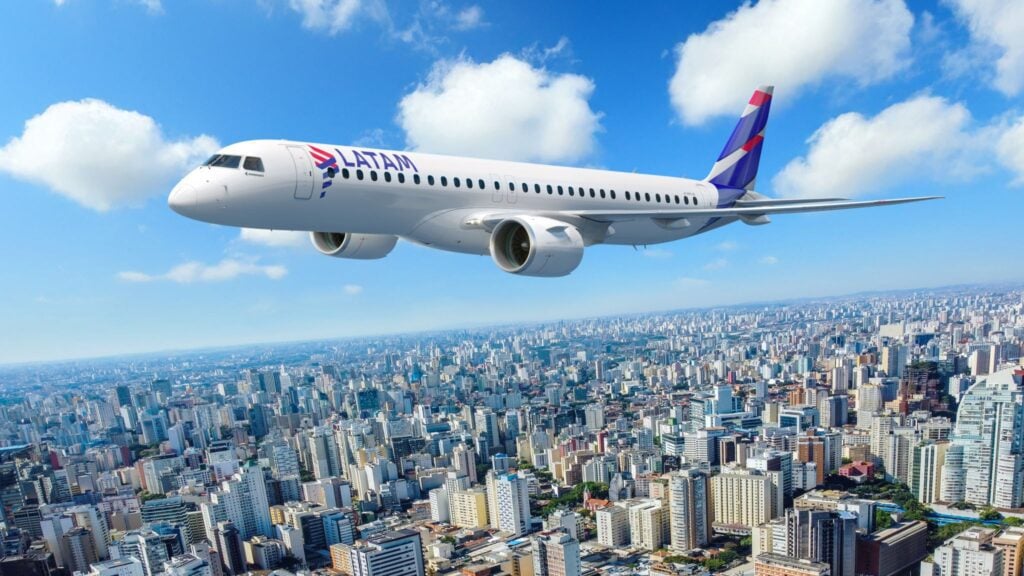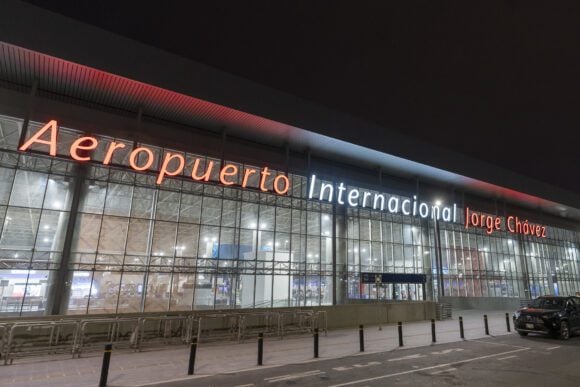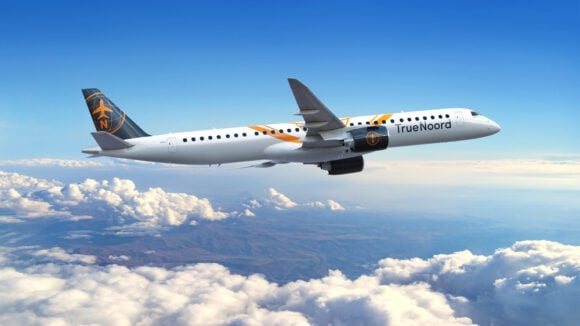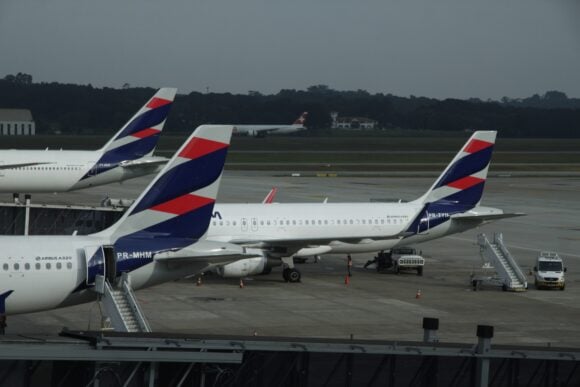
LATAM Embraer E195-E2
The agreement announced by LATAM Airlines Group for the acquisition of up to 74 Embraer E195-E2 aircraft is not a simple fleet renewal. It is a calculated strategic pivot, a move that transcends corporate logic to enter the realm of Brazilian industrial policy, enabled by the financial power of its development bank, BNDES. LATAM’s decision to introduce a new aircraft type from a different manufacturer, breaking a nearly decade-long doctrine of operational simplification, signals a fundamental redefinition of the concept of “efficiency.” The focus is no longer on fleet uniformity, but on granular network profitability.
This order marks the culmination of a series of political and economic maneuvers that have aligned the interests of the region’s largest airline with those of South America’s primary industrial power. For LATAM, the E195-E2 is the precise, almost surgical, tool to execute a new doctrine of expansion. It will allow the airline to open up to 35 new destinations in “thin” regional markets—those that were previously economically unviable for its fleet of Airbus A320s.
This move not only solves the succession of its aging A319 fleet but also launches a direct challenge to the business model of its main competitor in Brazil, Azul Linhas Aéreas, by invading the niche market that constituted its stronghold.
For Embraer, the deal is a historic victory. It secures its most prestigious customer in its home market and validates the competitiveness of its E2 program against its direct rival, the Airbus A220. However, the indispensable catalyst for this operation is Brazil’s National Bank for Economic and Social Development (BNDES). Through its financing mechanisms, the bank did not just facilitate the transaction; it shaped it as a centerpiece of Brazil’s “neo-industrialization” policy, using its influence to secure an order that strengthens its national aerospace champion.
Ultimately, LATAM’s order cannot be analyzed solely through a financial lens. It is a multifaceted event that redraws the competitive map of South American aviation, consolidates LATAM’s continental dominance, and exemplifies a new era of alignment between corporate power and national industrial policy.
Anatomy of a Deal: Figures, Timelines, and the Chosen Tool
For the first time since the merger that created the South American giant, LATAM Airlines Group committed to incorporating Brazilian-made regional aircraft—a decision with profound operational, strategic, and political implications.
Order Composition and Financial Aspects
The structure of the agreement reveals both a firm commitment and considerable future flexibility. It consists of:
- Firm Orders: 24 Embraer E195-E2 aircraft, the core of the initial commitment.
- Purchase Options: 50 additional options, bringing the total potential of the deal to 74 aircraft. This structure allows LATAM to scale its regional fleet based on market performance without a massive initial capital commitment.
The value of the firm portion is estimated at approximately $2.1 billion at list prices. While it is standard practice for airlines to negotiate significant discounts, the figure underscores the magnitude of the investment. Crucially, the group communicated that the investment is compatible with its financial policy. It assured markets that no changes are expected in its leverage and liquidity metrics, a sign that the acquisition was meticulously planned within its post-restructuring financial framework.
The integration plan is clearly defined. Deliveries of the 24 firm orders will begin in the second half of 2026, giving the airline a nearly one-year window to prepare its operations, crews, and maintenance.
The initial deployment will focus on LATAM Airlines Brasil, a decision that reflects the deal’s connection to the Brazilian market and politics. However, the contract explicitly provides the flexibility to assign the aircraft to other subsidiaries. This means the E195-E2s could eventually operate under LATAM’s banners in Peru, Colombia, Ecuador, or Chile, allowing the group to optimize asset allocation across its network.
LATAM’s New Doctrine: Why Complexity Trumped Simplification
The decision to incorporate the E195-E2 is a strategic pivot that subverts LATAM’s long-held fleet management doctrine. This move reveals an evolution in the airline’s thinking, driven by a post-restructuring focus on granular network profitability and a pragmatic adaptation to global supply chain realities.
“Right-Sizing” for Profitability: The Expansion Doctrine
The primary driver behind this order is the pursuit of profitable growth. LATAM stated this fleet will allow it to open up to 35 new destinations. The key is “right-sizing.” The E195-E2, with its 130-146 seat capacity, is the scalpel for an operation that previously only allowed a hammer—the Airbus A320. Its operating cost per trip is significantly lower, allowing LATAM to profitably enter “thin” regional routes with demand insufficient to consistently fill a larger aircraft. Serving these routes with an A320 would have resulted in low load factors and negative margins.
LATAM Group CEO Roberto Alvo confirmed this logic, emphasizing that the choice was based on the model’s “excellent economic efficiency and versatility.” It is a shift from a focus on efficiency through uniformity to one that prioritizes the profitability of each individual route.
LATAM’s fleet of 39 Airbus A319s, with an average age of 17 years, is the natural candidate for replacement. However, the airline recently announced a $40 million investment to modernize 37 of these aircraft, with completion scheduled for the second half of 2026—coinciding with the arrival of the first E195-E2s.
Far from being a waste, this is a pragmatic and astute “bridge strategy.” LATAM faces a dilemma: its A319s are operationally crucial but competitively weak, and immediate replacement with new Airbus jets is unfeasible due to long backlogs. The retrofit program elevates the A319’s product standard for a transition period of three to five years. It prevents the erosion of customer satisfaction while LATAM awaits and integrates the new Embraer fleet.
The Evolution of “Efficiency” in Post-Restructuring LATAM
For years, LATAM’s strategy was simplification, centered on the Airbus A320 family to reduce costs in maintenance, spare parts, and training. Introducing a new aircraft type from another manufacturer appears to be a reversal of this doctrine.
It is not a regression, but an evolution. It signals a redefinition of “efficiency.”
- The Old Paradigm: Efficiency was defined by operational simplicity. A homogenous Airbus fleet was the means to minimize Cost per Available Seat-Kilometer (CASK) through economies of scale.
- The New Paradigm: Efficiency is now defined by network profitability and maximizing Revenue per Available Seat-Kilometer (RASK). LATAM’s management now recognizes that operating a half-empty A320 on a regional route is financially inefficient, regardless of the aircraft’s commonality. The opportunity cost outweighs the benefits of uniformity.
LATAM is willing to accept a marginal increase in operational complexity in exchange for the benefit of deploying the most economically suitable aircraft for each mission.
The State’s Hand: BNDES as the Catalyst for Brazilian Industrial Policy
The deal between LATAM and Embraer cannot be understood as a simple commercial transaction. It was enabled by strategic maneuvers involving the Brazilian government and its powerful financial arm, BNDES. The signing in September 2025 was the culmination of a strategic courtship. The timeline is revealing:
- August 5, 2024: After a meeting between LATAM CEO Roberto Alvo and Brazilian President Luiz Inácio Lula da Silva, the airline announces a $2 billion investment in its Brazilian operations, including the expansion of its maintenance center in São Carlos.
- July-August 2024: Reports emerge that the Brazilian government was offering incentives to airlines operating regional routes with Embraer aircraft, with President Lula himself personally pushing for the deal. The head of BNDES reveals that LATAM is in “advanced discussions” with Embraer, explicitly linking LATAM’s investment in Brazil to a potential aircraft order.
- September 22, 2025: The agreement for up to 74 Embraer jets is formally announced.
This sequence shows the order did not arise from a vacuum but from a strategic dialogue where LATAM aligned its plans with the Brazilian government’s priorities.
The BNDES Financing Playbook
The role of BNDES is fundamental. It operates as an instrument of Brazil’s industrial policy. Its main mechanism is the BNDES Exim Post-shipment credit line, a buyer’s credit. BNDES finances the airline directly. Upon delivery, BNDES pays Embraer in Reais, and the airline repays the bank in dollars. This system insulates Embraer from default risk, provides the airline with competitive terms, and generates foreign currency for Brazil.
This financing is crucial for Embraer to compete on a “level playing field” with Airbus and Boeing, whose sales are backed by their own Export Credit Agencies. The president of BNDES, Aloizio Mercadante, was unequivocal: any financial support for airlines must have a “quid pro quo”—the purchase of Embraer aircraft.
The LATAM-Embraer deal is a textbook example of Brazil’s “neo-industrialization” policy, which seeks to revitalize high-tech sectors. The Brazilian government actively promotes high-value domestic industries like aerospace. By aligning with LATAM, the government secures a massive order for Embraer, incentivizes investment in MRO facilities on Brazilian soil, and fosters regional air connectivity. The transaction is a symbol of a successful public-private partnership.
Selected BNDES Financing Agreements for Embraer (2023-2025)
| Airline / Client | Aircraft Type | Number of Aircraft | Financing Value (BRL) |
|---|---|---|---|
| American Airlines | E175 | 3 | 24.5 billion |
| Horizon Air | E175 | 6 | 900 million |
| Republic Airways | E175 | 16 | 2.1 billion |
| Azul Linhas Aéreas | E195-E2 | 10 | 1.9 billion |
| Azorra (Lessor) | E190-E2 / E195-E2 | 8 | 1.1 billion |
| SkyWest / American / Azorra | E175 | 67 (2023 total) | up to 10 billion |
This table provides irrefutable proof of BNDES’s systematic, large-scale support, showing that the backing for LATAM is not an anomaly but part of a consistent strategy.
The Direct Challenge to Azul’s Citadel
Azul Linhas Aéreas built its business model by connecting secondary cities, often with an Embraer fleet. This strategy allowed it to operate many routes without competition, creating a highly profitable “citadel.” LATAM’s entry into the 130-150 seat segment with the E195-E2 is a direct assault on this strategic sanctuary. LATAM can now effectively compete on routes previously uneconomical for its A320s, leveraging its scale, brand, and network.
This move forces Azul to fight a war on two fronts while navigating its own financial restructuring:
- Front One (Trunk Routes): Where it already competes with LATAM and GOL, and where LATAM holds a structural advantage at key airports like Congonhas.
- Front Two (Regional Routes): Azul’s “citadel,” its high-margin safe haven.
By acquiring the E195-E2, LATAM has obtained the key to enter this citadel. It can now overlay its commercial power on Azul’s most profitable routes, forcing it to defend its core territory at a moment of vulnerability.
A Decisive Home-Turf Victory for Embraer
For Embraer, this order is a monumental victory. Securing the region’s largest airline group as a customer for its flagship program is an invaluable market endorsement. Historically, neither LATAM nor its predecessors operated Embraer regional jets.
The victory comes at the direct expense of the Airbus A220, which LATAM confirmed was under evaluation. The choice of the E195-E2 reinforces the Brazilian aircraft’s competitive credentials. The order also provides a significant boost to the E195-E2’s backlog, adding to recent wins with airlines like Avelo and SAS.
With this order, LATAM reinforces its network leadership in South America. The E195-E2s will not only open point-to-point routes but will also feed traffic to its hubs in São Paulo, Santiago, Lima, and Bogotá. By weaving a denser network, LATAM can capture a larger share of intra-regional traffic. The ability to open up to 35 new destinations will further solidify its market share, already around 40% in Brazil. This move, combined with its Joint Venture with Delta Air Lines, cements LATAM’s position as the undisputed leading airline group in the region.
Risks and Rewards for LATAM
The main risk for LATAM lies in the complexity and cost of integrating a new fleet type. It requires new maintenance lines, supply chains, and training programs. If these costs are not managed with discipline, they could erode efficiency gains. However, the potential rewards are immense: access to dozens of new profitable markets, stronger network effects, and unprecedented flexibility to match capacity with demand.
The most immediate impact will be felt in Brazil. LATAM’s entry into Azul’s regional domain will intensify competition, likely putting downward pressure on fares. Azul will be forced to respond strategically, either by accelerating its own fleet modernization or seeking alliances. Rumors of a potential merger with GOL could gain traction as a countermeasure. The competitive landscape in Brazil is set to become significantly more dynamic.
Ultimately, the LATAM-Embraer deal is a watershed moment. It signals the end of rigid fleet simplification strategies in favor of a more nuanced, margin-focused network optimization. It demonstrates that for an airline of LATAM’s scale, true efficiency can lie in controlled complexity.
More importantly, it exemplifies a new era of strategic alignment between a dominant corporation and a powerful state actor. The interplay between LATAM’s expansion strategy, Embraer’s need for an anchor customer, and Brazil’s desire to project its industrial power created a perfect confluence of interests.
Views: 346



